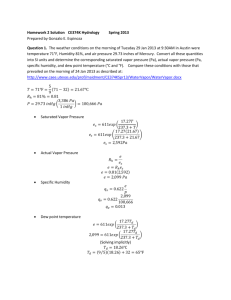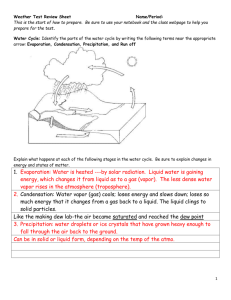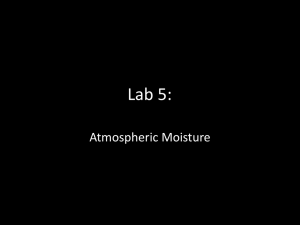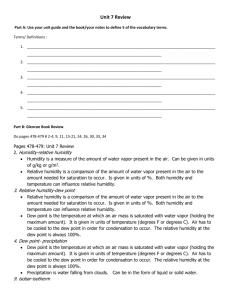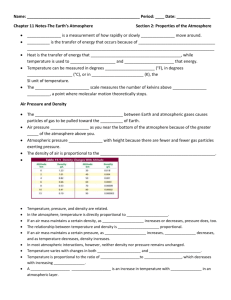Chapter 04
advertisement
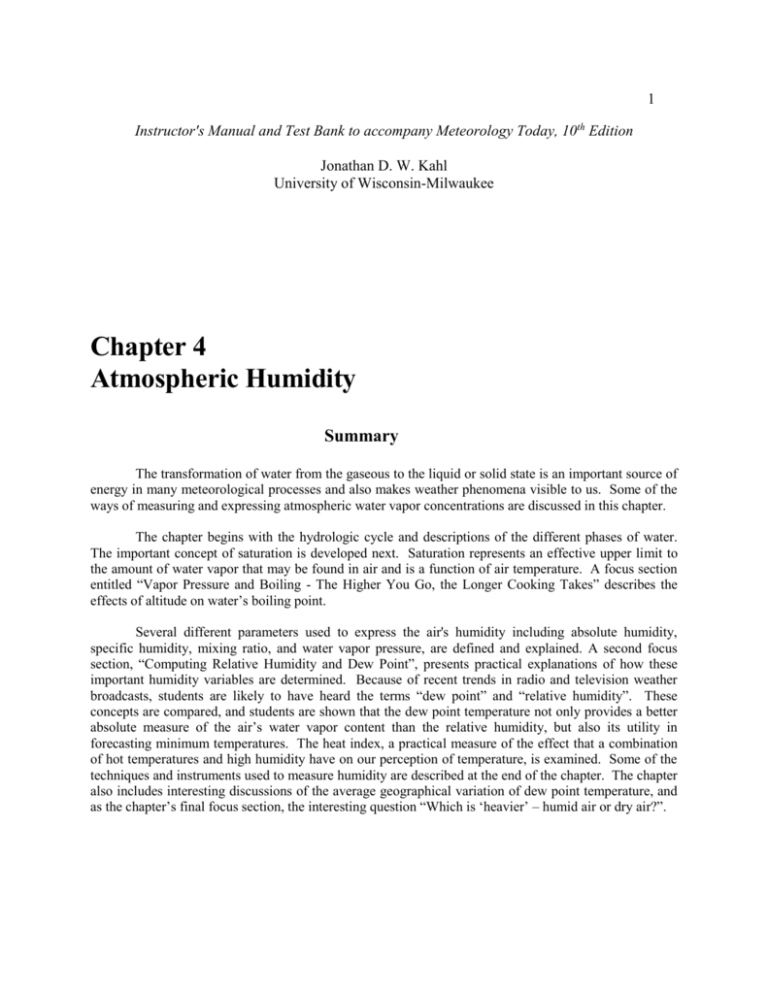
1 Instructor's Manual and Test Bank to accompany Meteorology Today, 10th Edition Jonathan D. W. Kahl University of Wisconsin-Milwaukee Chapter 4 Atmospheric Humidity Summary The transformation of water from the gaseous to the liquid or solid state is an important source of energy in many meteorological processes and also makes weather phenomena visible to us. Some of the ways of measuring and expressing atmospheric water vapor concentrations are discussed in this chapter. The chapter begins with the hydrologic cycle and descriptions of the different phases of water. The important concept of saturation is developed next. Saturation represents an effective upper limit to the amount of water vapor that may be found in air and is a function of air temperature. A focus section entitled “Vapor Pressure and Boiling - The Higher You Go, the Longer Cooking Takes” describes the effects of altitude on water’s boiling point. Several different parameters used to express the air's humidity including absolute humidity, specific humidity, mixing ratio, and water vapor pressure, are defined and explained. A second focus section, “Computing Relative Humidity and Dew Point”, presents practical explanations of how these important humidity variables are determined. Because of recent trends in radio and television weather broadcasts, students are likely to have heard the terms “dew point” and “relative humidity”. These concepts are compared, and students are shown that the dew point temperature not only provides a better absolute measure of the air’s water vapor content than the relative humidity, but also its utility in forecasting minimum temperatures. The heat index, a practical measure of the effect that a combination of hot temperatures and high humidity have on our perception of temperature, is examined. Some of the techniques and instruments used to measure humidity are described at the end of the chapter. The chapter also includes interesting discussions of the average geographical variation of dew point temperature, and as the chapter’s final focus section, the interesting question “Which is ‘heavier’ – humid air or dry air?”. 2 Teaching Suggestions 1. The dew point temperature can be determined by filling a metal cup or container with warm tap water (at least 50o F in winter and 75o F in summer). Place a thermometer in the water and begin to slowly add ice while continuously stirring the mixture. Read the temperature when the first sign of condensation begins to appear on the outside of the container. This reading should be within about 3 o F of the dew point temperature. 2. The reading above could be compared with a simultaneous measurement made using an aspirated psychrometer and with the current dew point temperature announced on the local weather broadcast. Students could be asked to measure the dew point temperature and the relative humidity indoors and outdoors and asked to account for any similarities or differences. 3. Saturation vapor pressure can be illustrated by filling a test tube with a few grams of solid iodine. The iodine will sublimate and fill the air in the test tube with iodine vapor. The iodine vapor has a purplepink color which should just be visible at normal room temperature when viewed against a white background. 4. Demonstrate the effect of temperature on the saturation vapor pressure. Enhance the previous experiment by immersing the bottom of a test tube with a few grams of solid iodine in hot water. The gas in the test tube will have a noticeably darker color indicating a higher vapor concentration. If this warm test tube is cooled, iodine vapor will be deposited on the sides of the test tube. With some care two test tubes (warm and cool) may be passed around a small class for examination. The iodine vapor is also visible when the test tubes are placed on an overhead projector. 5. Measure relative humidity with a sling psychrometer and a psychometric table. Discuss the difference between dew point and wet bulb temperatures. Why are there different psychometric tables for different atmospheric pressures? 6. Though experiment demonstrating latent heat: Ask students why they immediately feel cold when turning off the shower. The bathroom is warm, and the water on their (still wet) skin is warm. So why do they feel cold? 7. Discuss with students why perspiration is an effective way to cool skin. 8. In interior areas of Antarctica, relative humidities are usually quite high despite extremely low vapor pressures. Invite students to explain this apparent paradox. 9. Ask students why their skin often feels dry and uncomfortable in the winter and not (or at least less so) during summer. Encourage them to invoke the concepts of saturation vapor pressure and relative humidity. 10. Discuss the seemingly contradictory concept of humid air being less dense than dry air. Have students convince other students why this is in fact true. 3 Student Projects 1. Have students plot daily high and low temperatures together with average dew point temperature and an estimate of cloud cover for a period of a week or two. Were the coldest nighttime temperatures observed with clear or cloudy skies, dry or humid conditions? 2. Have students plot the daily temperature range (daily high minus daily low) against one of the moisture variables. Do any relationships emerge? 3. Have students track the dew point temperature each day for a week. How much variation is there in the dew point temperature from day to day? Can students explain sudden changes in the daily average dew point? Is there any correlation between visibility and dew point temperature? 4. Record the relative humidity and dew point temperature each day for a week, along with a subjective assessment of how humid the air feels. Which moisture variable, dew point or RH, gives a better indication of how humid the air feels? 5. Have students prepare an argument either for or against the following statement: The dew point temperature should be included in all weather reports. Answers to Questions for Review 1. The hydrologic cycle is an unending circulation of water between the ocean, land and atmosphere. The sun’s energy evaporates ocean water, atmospheric winds carry the water vapor to distant regions, and the water vapor condenses into liquid, forming clouds, and liquid (or solid) precipitation falls out of the clouds. When the precipitation falls on land, the water eventually returns to the ocean in rivers or evaporates back into the atmosphere. When precipitation falls onto the ocean, the cycle is complete. 2. Solid phase (ice): crystal, slow vibrational speed of the molecules. Liquid phase (liquid water), faster vibrational speeds. Gaseous phase (water vapor), fastest vibrational speeds. 3. Temperature, relative humidity and wind. 4. As temperatures drop, the speed of the water molecules decreases. 5. The rate of evaporation equals the rate of condensation above a saturated water surface. 6. With condensation, water vapor is removed from the atmosphere (it is changed from vapor to liquid water). With precipitation, solid or liquid water is removed from the atmosphere (it falls to the earth as rain or snow. 7. A rising or descending parcel of air will experience a change in its volume because of the changes in surrounding air pressure. Consequently, when a volume of air fluctuates, the absolute humidity changes—even though the air’s vapor content has remained constant. For this reason, the absolute humidity is not commonly used in atmospheric studies. Specific humidity and mixing ration, on the other hand, do not depend on the volume of the air. Specific humidity and mixing ratio can only change if 4 water vapor is added or taken away from an air parcel. 8. Actual vapor pressure indicates the number of water vapor molecules in an air parcel, whereas saturation vapor pressure describes how much water vapor is necessary to make the air saturated at any given temperature. Actual vapor pressure would be the same as saturation vapor pressure if the air were saturated. 9. Temperature. 10. Atmospheric pressure is lower at higher altitudes, so the saturation vapor pressure of the bubbles escaping from boiling water is also lower. These means that at higher altitudes, boiling occurs at lower temperatures, so food prepared in boiling water needs more time to cook. 11. (a) The ratio of the amount of water vapor actually in the air to the maximum amount of water vapor required for saturation at that particular temperature (and pressure). (b) Because the amount of water vapor required for saturation depends strongly on the temperature. (c) By changing the amount of water vapor in an air parcel, and by changing the temperature of the air. 12. As temperatures increase, the amount of water vapor required for saturation increases. Since this represents the denominator of the fraction in the RH equation, RH must be inversely proportional to temperature. 13. When the air temperature is high and the relative humidity low, perspiration on the skin evaporates quickly, often making us feel that the air temperature is lower than it really is. However, when both the air temperature and relative humidity are high and the air is nearly saturated with water vapor, body moisture does not readily evaporate; instead, it collects on the skin as beads of perspiration. Less evaporation means less cooling, and so we usually feel warmer than we did with a similar air temperature, but a lower relative humidity. 14. Because the wet-bulb temperature is the lowest temperature that can be reached by evaporating water into the air. On a hot day when the wet-bulb temperature is low, rapid evaporation (and, hence, cooling) takes place at the skin’s surface. As the wet-bulb temperature approaches the air temperature, less cooling occurs, and the skin temperature may begin to rise.When the wet-bulb temperature exceeds the skin’s temperature, no net evaporation occurs, and the body temperature can rise quite rapidly. Fortunately, most of the time, the wet-bulb temperature is considerably below the temperature of the skin. 15. Because water vapor molecules weigh less than the other molecules that make up most of the air (N2 and O2). On a hot humid day the percentage of lighter water vapor molecules is greater than on a hot dry day, thus the air on a hot humid day is lighter and less dense than on a hot dry day. 16. (a) the temperature to which air would have to be cooled (with no change in air pressure or moisture content) for saturation to occur. (b) When the difference between the dew point and the air temperature is large, the relative humidity is low. When the difference between the dew point and the air temperature is small, the relative humidity is high. 17. Because the very cold temperatures of polar air mean that the amount of water vapor required for 5 saturation is very small. Since this amount is the denominator of the fraction in the RH equation, a small value gives a large RH. 18. Large amounts of water vapor in the air will cause the specific humidity to be high. Very high air temperatures cause the RH to be low. So the combination of large amounts of water vapor and very high air temperatures gives high specific humidity and low RH. An example would be an offshore wind blowing onto a hot desert, such as is sometimes found in middle eastern countries. 19. Warmer temperatures in the Gulf of Mexico region increase the saturation vapor pressure of the air, allowing more water vapor to be present in the air. 20. The wet-bulb temperature is the lowest temperature that can be reached by evaporating water into the air. The dew point temperature is the temperature to which air would have to be cooled (with no change in air pressure or moisture content) for saturation to occur. The wet-bulb temperature is always slightly larger than the dew point temperature. The two can only be the same when the air is saturated. 21. Because building furnaces usually heat air without adding water vapor to it. This causes the air’s saturation vapor pressure to become much larger than its actual vapor pressure, thus reducing the relative humidity. 22. A psychrometer consists of two liquid-in-glass thermometers mounted side by side. One of the thermometers has a moist cloth placed over its bulb. When air is passed over the thermometer bulbs (by twirling, or ‘slinging’, it around), water evaporates from the moistened cloth. The latent heat needed for this evaporation comes partially from the thermometer bulb, thus reducing the wet-bulb thermometer’s temperature. The wet bulb temperature is similar to, but not exactly the same as the dew point temperature. Relative humidity is determined with the help of a chart called a psychometric table, which uses the dry bulb temperature and the difference in temperature between the two bulbs. 23. Because a strand of human hair is known to increase by 2.5 percent as the relative humidity increases from 0 to 100 percent. Answers to Questions for Thought 1. The water should evaporate from the glass more quickly on the windy, warm, dry summer day. 2. The clothes "dry" by sublimation - ice to vapor transformation at subfreezing temperatures. 3. (a) Absolute humidity decreases because the mass of water vapor remains constant as the volume of air increases. (b) The relative humidity increases as the parcel cools because the air approaches the dew-point temperature and the parcel approaches saturation. (c) Actual vapor pressure decreases slightly due to the reduced pressure inside the rising, expanding parcel. (d) Saturation vapor pressure decreases as the air cools because of the lower air temperature. (Each of these examples assumes that the air remains unsaturated) 4. According to Fig. 5.12, the smallest difference in the average water vapor pressure between July 6 and January would be in Nevada. Overall, the difference in vapor pressure between these two months is less in the western one-third of the United States than in the eastern two-thirds of the United States. 5. Sure. Nighttime temperatures can get quite low in the desert, causing the relative humidity to rise above 90 percent. 6. The dew point temperature is a measure of the air's actual water vapor content. evaporating into the air increases the air's water vapor content and the dew point rises. Water 7. (a) The cooler the air (morning) the closer the air is to being saturated with water vapor and the higher is its relative humidity. The warmer the air (afternoon) the farther it is from being saturated and the lower its relative humidity. (b) The temperature is lower in city with a relative humidity of 90 percent and higher in the city with a relative humidity of 40 percent. 8. The relative humidity indoors would be higher than before. The amount of water vapor in the air did not change. However, the cooler air indoors is now closer to being saturated. 9. The air is close to being saturated. The air temperature and dew point are close together. 10. In the dry air, the wick on the wet-bulb thermometer has dried out and the temperature reading is no longer the wet-bulb temperature. 11. The climate is quite dry in much of Arizona, Nevada, and California, thus the air is usually far from saturated with respect to liquid water. In these conditions evaporative coolers are quite effective in lowering the temperature by removing the latent heat of evaporation from the air. In Florida, Georgia, and Indiana, the climate is much more humid, thus evaporative coolers are not nearly as efficient. 12. Boil water in the pot and measure the boiling-point temperature. Use Fig. 1 in the Focus section "Vapor Pressure and Boiling" in the text to determine your pressure level. Relate this pressure to elevation (for altitudes near sea level, use a vertical pressure change of 10 mb/100 m). 13. The process of cooking the turkey, ham, potatoes and vegetables involves adding water vapor to the air, raising the relative humidity. The air feels "cozy and comfortable" because of the added humidity. The air feels warmer because with the high relative humidity, perspiration is relatively ineffective at cooling the skin. In contrast, cooking pizza doesn't add very much water vapor to the air, keeping the relative humidity lower. Answers to Critical Thinking Questions Figure 4.10. The saturation vapor pressure can be zero only if there is absolutely no water vapor molecules in the air. This is never the case. Figure 4.17. Some of the precipitation will evaporate before it reaches the ground, increasing the relative humidity beneath the cloud. Figure 4.20. Boiling water would add water vapor to the air inside the house, increasing both the relative humidity and the dew point. 7 Multiple Choice Exam Questions 1. If a glass of water was surrounded by saturated air, a. the level of the water in the glass would slowly decrease. b. the water's temperature would slowly increase. c. the level of the water in the glass would not change. d. the water's temperature would slowly decrease. ANSWER: C 2. When the air is saturated, which of the following statements is NOT correct? a. The air temperature equals the wet-bulb temperature. b. The relative humidity is 100 percent. c. The air temperature equals the dew point temperature. d. An increase in temperature will cause condensation to occur. e. The wet bulb temperature equals the dew point temperature. ANSWER: D 3. As the air temperature increases, the air's capacity for water vapor a. increases. b. decreases. c. remains constant. d. is unrelated to air temperature and can either increase or decrease. ANSWER: A 4. The total mass of water vapor stored in the atmosphere at any moment is about ____ of the world's supply of precipitation. a. 1 day b. 1 week c. 1 month d. 1 year ANSWER: B 5. If the amount of water vapor in the atmosphere remains constant, the humidity a. cannot change. b. must change. c. might change, depending on which measure of humidity is used. d. will only change if we're using absolute humidity as the measure of humidity. ANSWER: D 6. The density of water vapor in a given parcel of air is expressed by the a. absolute humidity. b. relative humidity. c. mixing ratio. 8 d. specific humidity. e. saturation vapor pressure. ANSWER: A 7. Which of the following will increase in a rising parcel of air? a. saturation vapor pressure b. relative humidity c. mixing ratio d. air temperature e. none of the above ANSWER: B 8. Which of the following will decrease in a rising parcel of air? a. relative humidity b. absolute humidity c. specific humidity d. all of the above ANSWER: B 9. The ratio of the mass of water vapor in a given volume (parcel) of air to the mass of the remaining dry air describes the a. absolute humidity. b. mixing ratio. c. relative humidity. d. dew point. ANSWER: B 10. When the air temperature increases, the saturation vapor pressure will a. increase. b. decrease. c. remain the same. d. vary over an increasingly broad range of values. ANSWER: A 11. the The maximum pressure that water vapor molecules would exert if the air were saturated is called a. b. c. d. absolute humidity. boiling point. mixing ratio. none of the above ANSWER: D 12. If water vapor comprises 3.5 percent of an air parcel whose total pressure is 1000 mb, the water 9 vapor pressure would be a. 1035 mb. b. 35 mb. c. 350 mb. d. 965 mb. ANSWER: B 13. A high water vapor pressure indicates a. a relatively large number of water vapor molecules in the air. b. a relatively small number of water vapor molecules in the air. c. a relatively high rate of evaporation. d. an abundant supply of condensation nuclei in the air. ANSWER: A 14. If the air temperature increased, with no addition or removal of water vapor, the actual vapor pressure would a. increase. b. decrease. c. stay the same. d. become greater than the saturation vapor pressure. ANSWER: C 15. When the air temperature is below freezing, the saturation vapor pressure over water is a. equal to zero. b. less than the saturation vapor pressure over ice. c. greater than the saturation vapor pressure over ice. d. equal to the saturation vapor pressure over ice. ANSWER: C 16. Ignoring the contributions of wind, a baseball would be expected to travel farther in warm, humid air because a. water vapor helps to lift the baseball even higher. b. water vapor sticks to baseballs. c. water vapor is less dense than dry air. d. none of the above ANSWER: C 17. The Gulf Coast states are more humid in summer than the coastal areas of Southern California mainly because of the a. higher air temperature in the Gulf States. b. lower air temperature in Southern California. c. higher water temperature in the Gulf of Mexico. d. low relative humidity of the air over the Pacific Ocean. 10 ANSWER: C 18. If very cold air is brought indoors and warmed with no change in its moisture content, the saturation vapor pressure of this air will ____ and the relative humidity of this air will ____. a. increase, increase b. decrease, decrease c. increase, decrease d. decrease, increase ANSWER: C 19. Evaporative coolers are primarily used in climates where the summers are a. hot and humid. b. hot and dry. c. cold and humid. d. cold and dry. ANSWER: B 20. Which of the following will increase the relative humidity in a home during the winter? a. increasing the thermostat setting b. lowering the temperature of the air inside the home c. sealing the house against drafts d. taking a shower and letting the air circulate through the home ANSWER: D Exhibit 4-1 The following four questions refer to the temperature and dew point data in the following cities: City City A City B City C City D 21. Air Temperature (°F) 95 10 30 50 Dew Point (°F) 76 10 21 42 Refer to Exhibit 4-1. Which city has the highest relative humidity? a. City A b. City B c. City C d. City D ANSWER: B 22. Refer to Exhibit 4-1. Which city has the LEAST amount of water vapor in the air? a. City A b. City B 11 c. City C d. City D ANSWER: B 23. Refer to Exhibit 4-1. Which city has the GREATEST amount of water vapor in the air? a. City A b. City B c. City C d. City D ANSWER: A 24. Refer to Exhibit 4-1. Which city has the HIGHEST saturation vapor pressure? a. City A b. City B c. City C d. City D ANSWER: A 25. The main reason why vegetables take longer to cook in boiling water at high altitudes is because a. water boils at a higher temperature with higher altitude. b. the temperature of the boiling water decreases with increasing altitude. c. there is less oxygen in the air at high altitude. d. saturation vapor pressure decreases with increasing altitude. ANSWER: B 26. The temperature at which water boils depends mainly on a. air temperature b. relative humidity c. air pressure d. air density e. the specific heat of air ANSWER: C 27. The percentage of water vapor present in the air compared to that required for saturation is the a. mixing ratio. b. absolute humidity. c. dew point. d. relative humidity. e. specific humidity. ANSWER: D 28. Suppose it is snowing outside and the air is saturated. The air temperature and dew point are both 15°F, and the actual vapor pressure is 3 mb. If this air is brought indoors and warmed to 75°F, what 12 would the relative humidity of this air be, assuming that its moisture content does not change? (The saturation vapor pressure at 75°F is 30 mb). a. 5 percent b. 10 percent c. 30 percent d. 50 percent e. 100 percent ANSWER: B 29. At what time of day is the relative humidity normally at a minimum? a. when the air temperature is highest b. just before sunrise c. about midnight d. when the air temperature is lowest ANSWER: A 30. The time of day when the relative humidity reaches a maximum value is usually a. at the time when the air temperature is highest. b. in the middle of the afternoon. c. at the time when the air temperature is lowest. d. just before sunrise. e. about midnight. ANSWER: C 31. The dew point temperature is a measure of the total amount of water vapor in the air. a. true b. false ANSWER: A 32. will As the air temperature increases, with no addition of water vapor to the air, the relative humidity a. b. c. d. remain the same. increase. decrease. increase until it becomes equal to the dew point temperature. ANSWER: C 33. The relative humidity is often near 100 percent in the polar regions. a. true b. false ANSWER: A 34. With which set of conditions below would you expect wet laundry hanging outdoors on a 13 clothesline to dry most quickly? I. II. III. IV. V. Air Temperature (°F) 60 40 60 40 60 a. b. c. d. e. Relative Humidity 75% 75% 50% 50% 75% Wind Speed (mph) 20 20 20 10 10 I II III IV V ANSWER: C 35. If the air temperature remains constant, evaporating water into the air will ____ the dew point and ____ the relative humidity. a. increase, increase b. increase, decrease c. decrease, increase d. decrease, decrease ANSWER: A 36. Suppose the dew point of cold outside air is the same as the dew point of the air indoors. If the door is opened and cold air replaces some of the warm air, then the new relative humidity indoors would be a. lower than before. b. higher than before. c. the same as before. d. impossible to tell from the information given ANSWER: B 37. If the air temperature in a room is 70°F, the saturation vapor pressure is 25 mb, the dew point temperature is 45°F, and the actual vapor pressure is 10 mb, then the relative humidity must be near ____ percent. a. 15 b. 20 c. 35 d. 40 ANSWER: D 38. Suppose saturated polar air has an air temperature and dew point of -10°C, and unsaturated desert air has an air temperature of 35°C and a dew point of 10°C. The desert air contains ____ water vapor and has a ____ relative humidity than the polar air. 14 a. b. c. d. more, lower more, higher less, lower less, higher ANSWER: A 39. A sling psychrometer directly measures the relative humidity. a. true b. false ANSWER: B 40. As the difference between the air temperature and the dew point increases, the relative humidity a. increases. b. decreases. c. remains constant at a value less than 100 percent. d. remains constant and equal to 100 percent. ANSWER: B 41. The temperature to which air must be cooled in order to become saturated is the a. minimum temperature. b. dew point temperature. c. wet-bulb temperature. d. freezing point. ANSWER: B 42. As the air temperature increases, with no addition of water vapor to the air, the dew point will a. remain the same. b. increase. c. decrease. d. increase and become equal to the air temperature. ANSWER: A 43. In a blinding snowstorm in Vermont, the air temperature and dew-point temperature are both 30°F. Meanwhile, under clear skies in Arizona, the air temperature is 85°F and the dew point temperature is 38°F. From this information, you could conclude a. there is more water vapor in the air in Arizona. b. there is more water vapor in the Vermont snowstorm. c. the same amount of water vapor is found in the air in Vermont and Arizona. d. Vermont and Arizona are both located next to the ocean. ANSWER: A 44. Which of the following is the BEST indicator of the actual amount of water vapor in the air? a. air temperature 15 b. saturatin vapor pressure c. relative humidity d. dew point temperature ANSWER: D 45. At 40°F, the atmosphere is saturated with water vapor. If the air temperature increases to 60°F, with no addition or removal of water vapor, one may conclude that the dew point is about a. 20°F. b. 40°F. c. 60°F. d. 100°F. ANSWER: B 46. The lowest temperature that can be attained by evaporating water into the air is known as the a. heat index. b. minimum temperature. c. wet-bulb temperature. d. frost point. e. wind chill temperature. ANSWER: C 47. This instrument uses wet-bulb and dry-bulb temperature to obtain relative humidity: a. infrared hygrometer b. sling psychrometer c. hair hygrometer d. electrical hygrometer ANSWER: B 48. Which of the following statements is not correct? a. The length of human hair changes as the relative humidity changes. b. During the winter, low relative humidity can irritate the mucus membranes in the nose and throat. c. The relative humidity is a measure of the air's actual water vapor content. d. A change in the air temperature can change the relative humidity. ANSWER: C 49. The instrument that measures humidity by measuring the amount of radiant energy absorbed by water vapor is the a. electrical hygrometer. b. infrared hygrometer. c. sling psychrometer. d. hair hygrometer. e. dew cell. 16 ANSWER: B 50. Nighttime temperatures rarely drop below the dew point temperature because a. the dew will absorb all the heat. b. saturation vapor pressures always increase at night. c. at saturation, latent heat of condensation is released into the air. d. b and c ANSWER: C Essay Exam Questions 1. With the aid of a figure, illustrate and describe the circulation of water in the atmosphere (the hydrologic cycle). 2. Bespectacled people know that when entering a warm building after being outdoors in subfreezing temperatures, condensation occurs on the lenses of their glasses. Why doesn’t condensation occur on the lenses when they go outside after a lengthy stay inside the warm building? 3. What is meant by the terms water vapor saturation and saturation vapor pressure? Why does the saturation vapor pressure increase with increasing air temperature? 4. Using the concept of supercooled water, explain why ice cubes sometimes feel “sticky” when taking them out of the freezer. 5. Explain why, at temperatures below freezing, the saturation vapor pressure over water is greater than the saturation vapor pressure over ice. 6. In terms of the air temperature and water vapor content, explain how the relative humidity normally changes during the course of a 24-hour day. 7. In order to reduce evaporation and conserve water, do you think it would be better to water a lawn in the early morning or early evening? 8. Would lowering the temperature in your home during the winter cause the relative humidity to increase or decrease? Why? 9. What physiological effects might you experience during very humid and very dry conditions? 10. Explain why the dew point temperature provides a better indication of the actual amount of water vapor in the air than the relative humidity. 11. Why is perspiration an effective means of cooling human skin? 12. Describe how a sling psychrometer can be used to determine the relative humidity or dew point. 17 13. Would hazy conditions generally indicate dry or humid conditions? 14. An enterprising travel agent trying to sell you a summer vacation package to Phoenix, Arizona, claims that the summertime relative humidity is above 90 percent. Can this be true? Explain. 15. How could you heat air without decreasing its relative humidity?


